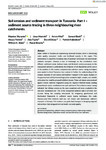Soil erosion and sediment transport in Tanzania: Part I – sediment source tracing in three neighbouring river catchments
| dc.contributor.author | Wynants, Maarten | |
| dc.contributor.author | Munishi, L | |
| dc.contributor.author | Mtei, K | |
| dc.contributor.author | Bodé, S | |
| dc.contributor.author | Patrick, A | |
| dc.contributor.author | Taylor, A | |
| dc.contributor.author | Gilvear, David | |
| dc.contributor.author | Ndakidemi, P | |
| dc.contributor.author | Blake, William | |
| dc.contributor.author | Boeckx, P | |
| dc.date.accessioned | 2021-12-16T10:56:00Z | |
| dc.date.available | 2021-12-16T10:56:00Z | |
| dc.date.issued | 2021-12-14 | |
| dc.identifier.issn | 0197-9337 | |
| dc.identifier.issn | 1096-9837 | |
| dc.identifier.uri | http://hdl.handle.net/10026.1/18469 | |
| dc.description.abstract |
<jats:title>Abstract</jats:title><jats:p>Water bodies in Tanzania are experiencing increased siltation, which is threatening water quality, ecosystem health, and livelihood security in the region. This phenomenon is caused by increasing rates of upstream soil erosion and downstream sediment transport. However, a lack of knowledge on the contributions from different catchment zones, land‐use types, and dominant erosion processes, to the transported sediment is undermining the mitigation of soil degradation at the source of the problem. In this context, complementary sediment source tracing techniques were applied in three Tanzanian river systems to further the understanding of the complex dynamics of soil erosion and sediment transport in the region. Analysis of the geochemical and biochemical fingerprints revealed a highly complex and variable soil system that could be grouped in distinct classes. These soil classes were unmixed against riverine sediment fingerprints using the Bayesian MixSIAR model, yielding proportionate source contributions for each catchment. This sediment source tracing indicated that hillslope erosion on the open rangelands and maize croplands in the mid‐zone contributed over 75% of the transported sediment load in all three river systems during the sampling time‐period. By integrating geochemical and biochemical fingerprints in sediment source tracing techniques, this study demonstrated links between land use, soil erosion and downstream sediment transport in Tanzania. This evidence can guide land managers in designing targeted interventions that safeguard both soil health and water quality.</jats:p> | |
| dc.format.extent | 3096-3111 | |
| dc.language | en | |
| dc.language.iso | en | |
| dc.publisher | Wiley | |
| dc.subject | geochemical fingerprinting | |
| dc.subject | sediment tracing | |
| dc.subject | compound specific stable isotope analysis | |
| dc.subject | Bayesian mixing models | |
| dc.subject | (sub)surface erosion | |
| dc.subject | land use | |
| dc.subject | East Africa | |
| dc.subject | river catchment | |
| dc.title | Soil erosion and sediment transport in Tanzania: Part I – sediment source tracing in three neighbouring river catchments | |
| dc.type | journal-article | |
| dc.type | Journal Article | |
| plymouth.author-url | https://www.webofscience.com/api/gateway?GWVersion=2&SrcApp=PARTNER_APP&SrcAuth=LinksAMR&KeyUT=WOS:000701325400001&DestLinkType=FullRecord&DestApp=ALL_WOS&UsrCustomerID=11bb513d99f797142bcfeffcc58ea008 | |
| plymouth.issue | 15 | |
| plymouth.volume | 46 | |
| plymouth.publisher-url | https://onlinelibrary.wiley.com/doi/10.1002/esp.5217 | |
| plymouth.publication-status | Published | |
| plymouth.journal | Earth Surface Processes and Landforms | |
| dc.identifier.doi | 10.1002/esp.5217 | |
| plymouth.organisational-group | /Plymouth | |
| plymouth.organisational-group | /Plymouth/Admin Group - REF | |
| plymouth.organisational-group | /Plymouth/Admin Group - REF/REF Admin Group - FoSE | |
| plymouth.organisational-group | /Plymouth/Faculty of Science and Engineering | |
| plymouth.organisational-group | /Plymouth/Faculty of Science and Engineering/School of Geography, Earth and Environmental Sciences | |
| plymouth.organisational-group | /Plymouth/REF 2021 Researchers by UoA | |
| plymouth.organisational-group | /Plymouth/REF 2021 Researchers by UoA/UoA14 Geography and Environmental Studies | |
| plymouth.organisational-group | /Plymouth/Research Groups | |
| plymouth.organisational-group | /Plymouth/Research Groups/Marine Institute | |
| plymouth.organisational-group | /Plymouth/Users by role | |
| plymouth.organisational-group | /Plymouth/Users by role/Academics | |
| plymouth.organisational-group | /Plymouth/Users by role/Researchers in ResearchFish submission | |
| dcterms.dateAccepted | 2021-08-07 | |
| dc.rights.embargodate | 2021-12-17 | |
| dc.identifier.eissn | 1096-9837 | |
| dc.rights.embargoperiod | Not known | |
| rioxxterms.versionofrecord | 10.1002/esp.5217 | |
| rioxxterms.licenseref.uri | http://www.rioxx.net/licenses/all-rights-reserved | |
| rioxxterms.licenseref.startdate | 2021-12-14 | |
| rioxxterms.type | Journal Article/Review | |
| plymouth.funder | "International". Jali Ardhi [Care for the Land] project: Realising land management change in degraded Maasai grazing lands.::NERC | |
| plymouth.funder | "International". Jali Ardhi [Care for the Land] project: Realising land management change in degraded Maasai grazing lands.::NERC | |
| plymouth.funder | "International". Jali Ardhi [Care for the Land] project: Realising land management change in degraded Maasai grazing lands.::NERC |


